- Trending:
- Pope Leo Xiv
- |
- Israel
- |
- Trump
- |
- Social Justice
- |
- Peace
- |
- Love
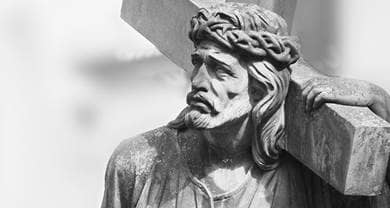
RELIGION LIBRARY
Christianity
Sacred Texts
| The canonical Christian Bible (bracketed books are not accepted by all denominations) |
|
| Old Testament | |
| Pentateuch | Genesis, Exodus, Leviticus, Numbers, Deuteronomy |
| Historical Books | Joshua, Judges, Ruth, 1 Samuel, 2 Samuel, 1 Kings, 2 Kings, 1 Chronicles, 2 Chronicles, Ezra, Nehemiah, [Tobit], [Judith], Esther, [1 Maccabees], [2 Maccabees] |
| Wisdom Books | Job, Psalms, Proverbs, Ecclesiastes, Song of Solomon, (Song of Songs), [Wisdom], [Sirach] |
| Major Prophets | Isaiah, Jeremiah, Lamentations, [Baruch], Ezekiel, Daniel |
| Minor Prophets | Hosea, Joel, Amos, Obadiah, Jonah, Micah, Nahum, Habakkuk, Zephaniah, Haggai, Zachariah, Malachi |
| New Testament | |
| Gospels | Matthew, Mark, Luke, John |
| Apostolic History | Acts |
| Letters of Paul | Romans, 1 Corinthians, 2 Corinthians, Galatians, Ephesians, Philippians, Colossians, 1 Thessalonians, 2 Thessalonians, 1 Timothy, 2 Timothy, Titus, Philemon |
| Other Letters | Hebrews, James, 1 Peter, 2 Peter, 1 John, 2 John, 3 John, Jude |
| Apocalypse | Revelation |
Christian scriptures are gathered in the Bible. The word bible comes from the medieval Latin biblia, which means books. Not all the literature produced in Judaism and Christianity is in the Bible. The list of books collected in the Bible is called the canon, a Greek word that means rule or norm. The canon contains only those books considered authoritative, and therefore read regularly, studied, and used in religious services.
Christianity collects the Jewish scriptures in the Old Testament. Twenty-seven manuscripts from the 1st century of the Common Era are collected in the New Testament. The first Christians defined testament in the sense of "will and testament," or "covenant," so the Old Testament is the record of the sacred covenant between God and the people through Abraham and Moses, and the New Testament is the record of the new Christian covenant through Jesus.
Because Judaism and Christianity canonized, or authoritatively affirmed, the scriptures separately, the first Christians included seven books in the Old Testament that were not in the Jewish canon. The Christian Old Testament and the Jewish scriptures were different until the Protestant Reformation, when reformers revised the Old Testament canon to agree with the Jewish canon. The Catholic Bible now refers to these seven books as deuterocanonical (meaning "belonging to the second canon"), while the Protestant Bible refers to them as apocryphal (meaning "outside the canon"), and some Protestants do not recognize them as having any kind of canonical status.
The early followers of Jesus were Jews, and so their scriptures were the Jewish scriptures. They read them and studied them, praying their prayers and singing their songs. When eyewitnesses to the life of Jesus began dying, their memories became precious. People began writing them down. Soon there was a proliferation of gospels and letters, and churches began the process of vetting them for authenticity.
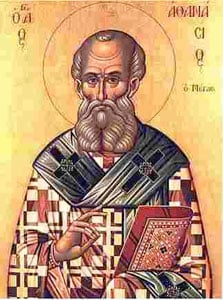
The idea of a New Testament canon first emerged in the 2nd century C.E., when Church leaders began making lists of the books determined to be authentically apostolic. In 367, Athanasius of Alexandria listed all twenty-seven books of the New Testament in a letter and referred to it as the canon. Athanasius's list was widely recognized in the eastern churches, and then was approved by a number of authoritative councils in the West. In this way the New Testament became the second part of the Christian Bible.
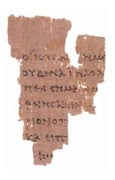 The twenty-seven books of the New Testament were all written in Greek. The four Gospels each give an account of the life of Jesus, highlighting the events leading up to and including his death by crucifixion and subsequent resurrection. They conclude with the events after his death, when followers shared stories of having seen Jesus alive again. The Book of Acts, which was originally part of the Gospel of Luke, gives an account of the first Christians and the apostles Peter and Paul.
The twenty-seven books of the New Testament were all written in Greek. The four Gospels each give an account of the life of Jesus, highlighting the events leading up to and including his death by crucifixion and subsequent resurrection. They conclude with the events after his death, when followers shared stories of having seen Jesus alive again. The Book of Acts, which was originally part of the Gospel of Luke, gives an account of the first Christians and the apostles Peter and Paul.
 The twenty-one epistles, or letters, are examples of communications between individuals and groups within the Christian communities of the first century. The last book, Revelation, is also an epistle, though it is distinctly symbolic and apocalyptic in content.
The twenty-one epistles, or letters, are examples of communications between individuals and groups within the Christian communities of the first century. The last book, Revelation, is also an epistle, though it is distinctly symbolic and apocalyptic in content.
Each Gospel was written anonymously, but is traditionally attributed to an apostle or a follower. The Gospel According to Matthew, probably written during the last decades of the 1st century, is traditionally attributed to the apostle and eyewitness Matthew. It was written for a Church coping with persecution and internal dissent. Matthew stresses that Jesus was the Jewish Messiah, the fulfillment of God's promise, and that his followers are the true Israel.
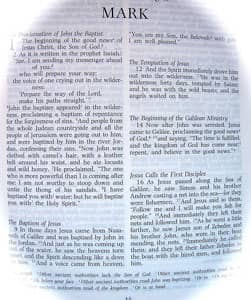 The Gospel According to Mark, written around 65-70, is alternately attributed to the Mark named in 1 Peter 5:13 or the John Mark mentioned in Acts 12:12. It was probably written for a community that was suffering persecution and seeking the immediate return of Jesus. Mark describes the people of Jesus' time, including his followers and the religious authorities, as unable to comprehend Jesus' true nature. The Gospel assures its audience that the revelation of Jesus' true nature was accomplished through his suffering, death, and resurrection.
The Gospel According to Mark, written around 65-70, is alternately attributed to the Mark named in 1 Peter 5:13 or the John Mark mentioned in Acts 12:12. It was probably written for a community that was suffering persecution and seeking the immediate return of Jesus. Mark describes the people of Jesus' time, including his followers and the religious authorities, as unable to comprehend Jesus' true nature. The Gospel assures its audience that the revelation of Jesus' true nature was accomplished through his suffering, death, and resurrection.
 The Gospel According to Luke, written around 80-85, is traditionally attributed to "the beloved physician" named in Colossians 4:14. It was written for a predominantly Gentile community in a Greek-speaking setting. Luke argues that the return of Jesus and the end of the world is not imminent, saying that the time cannot be known. Instead, Luke's Gospel emphasizes the nature of the Kingdom of God and the way it is made real in the lives of the communities of believers.
The Gospel According to Luke, written around 80-85, is traditionally attributed to "the beloved physician" named in Colossians 4:14. It was written for a predominantly Gentile community in a Greek-speaking setting. Luke argues that the return of Jesus and the end of the world is not imminent, saying that the time cannot be known. Instead, Luke's Gospel emphasizes the nature of the Kingdom of God and the way it is made real in the lives of the communities of believers.
| New Testament Gospels | |
| Synoptic Gospels | Matthew, Mark, Luke |
| Non-synoptic Gospels | John |
The Gospels of Matthew, Mark, and Luke have a number of similarities, including similar stories told in a similar order. They are called the synoptic Gospels (synoptic is a Greek word roughly translated as "seen together"). The Gospel According to John is noticeably different from the synoptic Gospels. It is traditionally attributed to the apostle John, son of Zebedee. Its date of composition is uncertain, but probably falls around 90-100. It places a strong theological emphasis on Jesus as the Son of God and on the possibility of eternal life through faith in him.
| Books attributed to Luke(c. 80-85 CE) |
| *The Gospel According to Luke *Acts of the Apostles |
The second volume of the Gospel According to Luke, the Acts of the Apostles, was written at the same time as Luke, around 80-85. Its main characters are the apostles Peter (chapters 1-12) and Paul (chapters 12-28). This book is the only known continuous record of the expansion of the communities of believers during the thirty years following Jesus' death. The author hopes to establish a common theological outlook between Peter and Paul in regard to faith and its relationship to the Jewish law.
| New Testament Epistles (many scholars doubt whether Paul wrote the bracketed letters) |
|
| Letters of Paul | Romans, 1 Corinthians, 2 Corinthians, Galatians, [Ephesians], Philippians, [Colossians], 1 Thessalonians, [2 Thessalonians], [1 Timothy], [2 Timothy], [Titus], Philemon |
| Other Letters | Hebrews, James, 1 Peter, 2 Peter, 1 John, 2 John, 3 John, Jude |
| Apocalypse | Revelation |
The New Testament contains twenty-one epistles, or letters. Christian leaders like Paul used letters to maintain contact with congregations. Most of the epistles are attributed to early community leaders. Thirteen are attributed to Paul, although Ephesians, Colossians, and 2 Thessalonians differ from Paul's other letters in either style or theological perspective. Many doubt that 1 and 2 Timothy and Titus, the so-called Pastoral Letters, are genuinely works of Paul. Paul's letters are clearly correspondences with specific communities, while the pastoral letters show concern with sending advice on pastoral or practical matters.
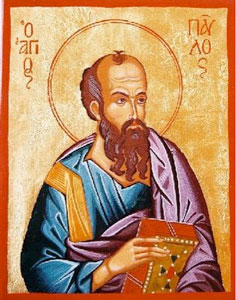
The non-Pauline epistles include one anonymous work (Hebrews), two that are attributed to Peter, one attributed to James (an early Christian leader), three attributed to the apostle John, and one attributed to Jude (another early Christian leader). Most of these are addressed to believers generally; James, for example, is a circular, and Hebrews is a sermon.
| Books attributed to John, son of Zebedee (c. 95 CE) |
|
The final book of the New Testament is Revelation. Its author is uncertain, although it is traditionally attributed to the apostle John, son of Zebedee, also credited with the Gospel According to John and the epistles of 1, 2, and 3 John. It was probably written around 95, and is addressed to seven congregations in the Roman province of Asia, although it is also intended for "the churches." While also an epistle, Revelation is an apokalypsis or Apocalypse, a literary genre common in Judaism around this time. It is distinctively Christian, and the only complete apocalypse included in the New Testament. Revelation is carefully constructed and is full of symbolic numerology, also common at the time in both Jewish and Greco-Roman writings. It predicts the fall of Rome and the transformation of Jerusalem into a heavenly city, the center of God's fully redeemed world.
The Bible has been published, in whole or in part, into over 2,000 languages. It is also easily accessible in several translations on the internet.
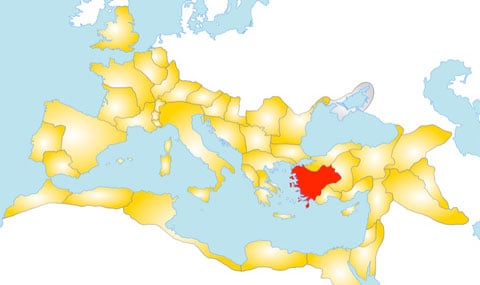
Study Questions:
1. What is the biblical canon? What does it contain and how is it organized?
2. How did Christianity's canon differ from Judaism's?
3. Describe the four gospels of Christianity.
4. What is an apocalypse? What book of the Bible could be classified as this, and why?










